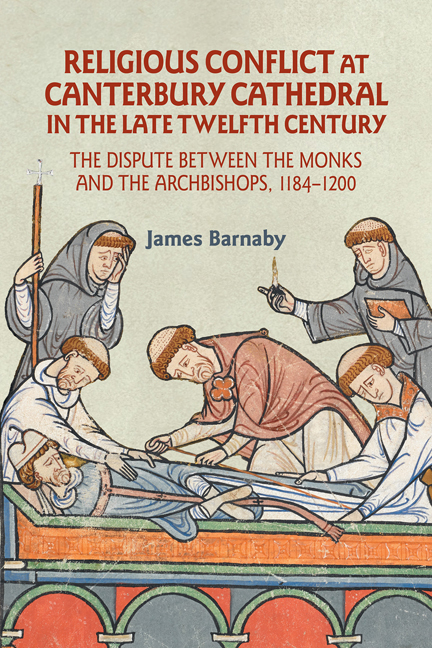 Religious Conflict at Canterbury Cathedral in the Late Twelfth Century
Religious Conflict at Canterbury Cathedral in the Late Twelfth Century Book contents
- Frontmatter
- Dedication
- Contents
- List of Maps
- Acknowledgements
- List of Abbreviations
- Introduction
- 1 The Canterbury Dispute in the Sources
- 2 Baldwin's Grand Plan (1184–November 1186)
- 3 To Rome (November 1186–July 1187)
- 4 The Hackington Dispute (August 1187–September 1189)
- 5 A New King, A Crusading Archbishop, and A Temporary Peace (September 1189–August 1191)
- 6 A New Primate (1191–3)
- 7 The Dispute Renewed (1193–1200)
- 8 After Lambeth: The Dispute in Later Centuries
- Conclusion
- Appendices
- Timeline
- Select Bibliography
- Index
- Other volumes in Studies in the History of Medieval Religion
1 - The Canterbury Dispute in the Sources
Published online by Cambridge University Press: 09 May 2024
- Frontmatter
- Dedication
- Contents
- List of Maps
- Acknowledgements
- List of Abbreviations
- Introduction
- 1 The Canterbury Dispute in the Sources
- 2 Baldwin's Grand Plan (1184–November 1186)
- 3 To Rome (November 1186–July 1187)
- 4 The Hackington Dispute (August 1187–September 1189)
- 5 A New King, A Crusading Archbishop, and A Temporary Peace (September 1189–August 1191)
- 6 A New Primate (1191–3)
- 7 The Dispute Renewed (1193–1200)
- 8 After Lambeth: The Dispute in Later Centuries
- Conclusion
- Appendices
- Timeline
- Select Bibliography
- Index
- Other volumes in Studies in the History of Medieval Religion
Summary
The Canterbury dispute is one of the best chronicled of the late twelfth century. With over 600 surviving letters, and a chronicle of which over half is dedicated to the events of the conflict, we have evidence for this dispute which simply does not exist for many of the other conflicts at the time, apart from the Becket affair. These sources allow us to build a highly detailed picture of the events of the conflict, yet we must still tread carefully. Of the surviving letters, just under one sixth are from the archbishops or their supporters. The result is a thoroughly monastic picture of the dispute, which is also reflected in Gervase's Chronica. While we get an excellent picture of how the monks felt and acted in the dispute, this is much harder to achieve regarding the archbishops. We must therefore look closely at the monastic sources to understand why they have constructed the narrative they wish to present.
Lambeth Ms 415
The main body of the Canterbury letters survives in a single manuscript housed in the archbishop's library at Lambeth Palace (Ms 415). The manuscript is quarto in size, containing 140 folios, with two clasps, one of which is now missing. It was rebound in the seventeenth century and embossed with the arms of the scholar and collector of historical documents Archbishop Sancroft (1677–90). The original title was ‘Epistolae Reginaldi de Tempore Baldewini’, but Sancroft added a more detailed title on the facing page, as well as making several annotations to the margins of the text. The fate of the manuscript after the dissolution of the monasteries in the sixteenth century is unclear. Several names have been written on the fly leaves, including Thomas Draper and Beaufey (suggesting possible owners) as well as ‘Eaton’ and ‘Aetonae’, indicating a potential home during this time. Before November 1610, the manuscript was acquired by Archbishop Bancroft. In his will, Bancroft left his library of 6,065 books to his successor, so long as they remained as a body for the use of all future archbishops. This donation was to be the founding collection for a permanent archiepiscopal library, after Archbishop Matthew Parker had alienated the earlier collections. Lambeth 415, took its place in this new collection.
- Type
- Chapter
- Information
- Religious Conflict at Canterbury Cathedral in the Late Twelfth CenturyThe Dispute between the Monks and the Archbishops, 1184-1200, pp. 9 - 32Publisher: Boydell & BrewerPrint publication year: 2024
